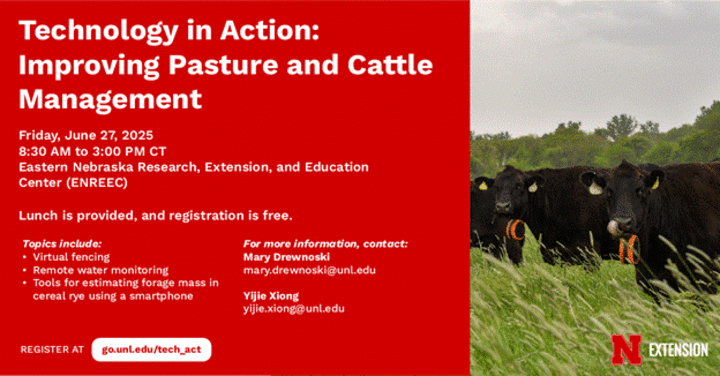
Nebraska Extension Educator - Holt/Boyd Counties - LaDonna Werth
Nebraska Extension Educator - Holt/Boyd Counties - Amy Timmerman
Nebraska Extension Educator - Brown/Rock/Keya Paha Counties - Brittany Spieker
Nebraska Extension Educator - Holt/Boyd/Garfield/Loup/Wheeler Counties - Bethany Johnston
Nebraska 4-H Assistant - Holt/Boyd Counties - Debra Walnofer
June 11-12: Tractor and Equipment Safety Training, AKRS Equipment Solutions, Inc, register at go.unmc.edu/tractor-safety-training
June 11: Young Rancher Workshop - Nebraska Grazing Lands Coalition and Ranch Management Consultants - Burwell, Nebraska, Contact Leah Peterson: director@nebraskagrazinglands.org, 308-872-1250
June 13: 4-H Rabbit Tattooing, 9:00am-4:30pm, Holt County Extension Office, O’Neill, NE
June 15: DUE: ALL Other Clover Kid, 4-H and FFA Animal ID Sheets, Holt County Extension Office, O’Neill, NE
June 15: DUE: Nebraska 4-H Enrollment Deadline
Can You Find... A Moment of Peace? Outdoor Play for Toddlers Just Got a Whole Lot Easier
Tired of hearing “I’m bored!” before you even finish your first sip of coffee? “Let’s Go Outside - Can You Find?” program from Nebraska Extension - Fit and Healthy Kids might just be your new favorite parenting tool - and your toddler’s favorite adventure.
What is it?
“Let’s Go Outside - Can You Find?” is a free, nature-based scavenger hunt series designed specifically for toddlers and preschoolers. Each activity takes children outdoors to explore their world with curiosity and creativity - while secretly building skills like fine motor coordination, sensory awareness, and early critical thinking.
From finding pinecones and dandelions to making shadow art and flower bracelets, every week brings a new mission that’s part playtime, part learning, and 100% engaging.
Why it matters:
Research shows that outdoor play helps children develop socially, emotionally, and physically. And let’s be honest - it gives parents a much-needed breather and a reason to say, “Let’s go outside!” instead of “Please stop jumping off the couch.”
Each activity includes:
LaDonna Werth
Extension Educator
Phone: 402-336-2760
E-mail: lwerth2@unl.edu

- Simple materials (think paper, crayons, nature),
Book suggestions to extend learning, - Play prompts and parent tips,
- Easy-to-follow steps for success (and fun).
How to start:
Just head over to https://go.unl.edu/letsgooutside to download the full set of “Let’s Go Outside - Can You Find?” guides. Whether you’re hunting for tree knots or chasing shadows, “Can You Find?” turns any patch of grass into a playground of possibilities.
Because the best memories? They don’t happen in front of a screen - they happen in a pile of crunchy leaves, with sticky fingers, messy hair, and lots of giggles.
Now go ahead - lace up those little sneakers and see what your child can find… and what you might rediscover, too.
Scout Emerging Corn for Insects; Don’t Assume Protection
As corn begins to emerge, be alert to the potential for damage from early season insects such as cutworms, wireworms, white grubs, or other insects. A key distinction to be aware of is that soil insects such as white grubs and wireworms can only be controlled with planting time treatments; cutworms and other caterpillars potentially can be controlled post-emergence.
Wireworms and white grubs are most often associated with fields that have been in pasture or CRP where grasses were allowed to grow for more than one year. It is rare to see these problems in continuous corn, but exceptions happen. Since wireworms and white grubs feed underground and cutworms feed on or below the soil surface, scout for plant damage aboveground, but then also dig in soil around the plant to identify the insect causing the damage.
Cutworms
Cutworms and other insects may hinder emerging corn plants this spring, even if seed was treated with insecticide or Bt corn hybrids were used. High populations of insects can overwhelm the protection method, regardless of whether it was an insecticide applied at planting (liquid, granular, or seed treatment) or a Bt corn hybrid.
In some cases, products are not labeled for the full spectrum of Nebraska insects. For example, Bt corn hybrids expressing the Cry 1F and VIP3A Bt proteins list control of black cutworm on the label, but only VIP3A lists control of another soil cutworm (dingy cutworm) species. See the Handy Bt Trait Table for a list of which hybrids express which Bt proteins.
Amy Timmerman
Extension Educator
Phone: 402-336-2760
E-mail: atimmerman2@unl.edu

Cutworms can cause serious damage to corn in the first of couple weeks after emergence so it is important to scout fields early for damage. Several species of cutworms attack corn. The severity and the area affected will vary greatly, depending on species involved, previous crop history, and weather conditions.
The black cutworm does not overwinter in Nebraska, and infestations depend on moths moving up in spring winds from the south. They are most commonly found in the eastern one-fourth of the state. Fields with winter annual weeds or abundant crop residue are more attractive to the egg-laying black cutworm moths in the spring. Black cutworm moths may also be attracted to dense cover crop vegetation to lay eggs. Black cutworm larvae are light gray to nearly black in color with an overall greasy appearance and reach 1.5 inch long at maturity. When viewed through a hand lens, the skin has a rough pebbly texture. The head has two black stripes and there is a pale band along the top of the body. A key characteristic is that on the top of each abdominal segment there are two sets of paired spots which are unequal in size.
After hatching, cutworm larvae may begin feeding on the cover crop and later move to a cash crop when the cover crop is terminated. In 2016, Dunbar et al. captured significantly higher numbers of black cutworm moths in rye cover crop plots from late April through early May in Iowa. A couple of weeks later corn plants were assessed for cutworm damage, but no significant cutworm damage was observed. Such observations reinforce the need to scout fields even when adults have been observed. True armyworm has a similar behavior to black cutworm in that it targets areas of dense vegetation for egg laying.
Several other cutworm species (dingy, claybacked, army, and Sandhills cutworms) overwinter as partly grown caterpillars and can be found more widely in Nebraska.
Dingy cutworms are pale gray to reddish brown with mottled pigmentation and light gray with a V-shaped marking on the back of each abdominal segment. In addition, dingy cutworms have two pairs of equal-sized tubercles on each segment, a key distinction from black cutworms where the pairs of tubercles are unequal in size. Because they overwinter as larvae, dingy cutworms are often the first to damage corn in the spring; however, they generally cause less damage than black cutworms because they feed primarily on leaves and do not typically cut stems. In most cases, treatment for dingy cutworms is not justified unless extensive feeding accompanies poor growing conditions.
Army cutworm larvae are generally greenish-grey to greenish-brown with a freckled appearance. The larvae usually have a narrow, pale stripe on top. Mature larvae are approximately 1 ½ to 2 inches in length. The adults migrate to the Rocky Mountains in the summer to avoid high temperatures before returning to the plains in the late summer to lay eggs. Eggs hatch in the fall and larvae begin development before overwintering.
Army cutworm larvae become active again in the late winter to early spring. Like dingy cutworms, they are among the first cutworms to appear in the spring; however, army cutworms generally climb and feed on leaves, so they typically cause less injury than cutworms that feed below ground on the stem. In addition, because they are most abundant early in the season, they usually only injure wheat and other small grains, as well as alfalfa.
Claybacked cutworms are generally light along the sides with a darker brownish to reddish broad stripe on the back. At maturity, larvae can reach up to approximately 1 ½ inches in length. However, unlike dingy and army cutworms, claybacked cutworms will cut plants just above soil surface and can be economically important occasionally.
Remember that early detection of a problem is essential because most cutting occurs within seven days of plant emergence.
Treatment
Generally, a post-emergence "rescue" treatment should be considered if cutting is observed on 3-5% or more of plants and the worms are one inch or less in length. Rescue treatments are effective in controlling soil cutworms.
Wireworms
Wireworms are the larvae of click beetles. The adult beetles prefer to lay eggs in grass and the larvae can remain in that stage for up to six years, depending on the species. Wireworms are our earliest corn pests each season, as they can feed on the seed before germination, causing reduced plant emergence. Later feeding may kill or stunt small plants.
All wireworm feeding is done underground. Wireworms are white, yellow, orange, or brown with hard shells. They tend to be more numerous in fields that have been in grass or pasture or fields that have had grassy weed problems. Wireworms prefer cooler soil temperatures under 70°F, so fields that were planted early or have heavy surface residue may be at higher risk than tilled fields.
Treatment
There is no rescue treatment for wireworms, so the main decision at this time is whether there is sufficient stand reduction to warrant replanting. Fields with high populations of wireworms should be prioritized for control measures next year if they are to be replanted to corn. The use of seed treatments like Cruiser and Poncho has greatly reduced the incidence of wireworm damage. These products are excellent early season stand protectors.
White Grubs
White grubs are the larvae of May (or June) beetles and Japanese beetles. They prefer to feed on grasses and most commonly damage corn in eastern Nebraska. There are two basic types of grubs:
Annual grubs complete their development in one year. Both masked chafers and Japanese beetles have similar life cycles. They do most of their feeding in the late summer and fall and are not considered serious pests of spring-planted field crops.
Three-year grubs, however, can damage corn severely in the last two years of their larval stage. The larvae overwinter deep in the soil. As the soil warms, they begin feeding on plant roots. Damage to corn may not occur until the corn is in the 2- to 6-leaf stage. This is difficult because up to the time of feeding, the stand may look fine. Often three-year grub damage is near shelter belts where the adults may congregate to feed and mate. One way to distinguish three-year grubs from annual white grubs is by the parallel rows of spines. Annual white grub spines are scattered randomly.
To identify white grubs, examine the pattern of spines on the underside of the last abdominal segment. Three-year grubs have two rows of parallel spines in a line; annual white grubs have spines scattered randomly.
Treatment
Like wireworms, there is no rescue treatment for white grubs. Again, high risk areas (e.g., presence of three-year grubs the previous year) need to be treated at planting. Products for white grub control are similar to wireworm control.
Replanting
If wireworm or white grub damage is serious enough to warrant replanting, consider use of planting time insecticide treatments, although the odds of damage diminish with the warming of the soil.
Source: Robert Wright - Extension Entomologist, Kyle Koch - Assistant Extension Educator, Justin McMechan - Crop Protection and Cropping Systems Specialist; Updated By: Kyle Koch - Assistant Extension Educator, Justin McMechan - Crop Protection and Cropping Systems Specialist, Julie Peterson - Extension Entomologist
Strategies to Consider When Culling Cows in 2025
Following a spring with below-average precipitation for much of Nebraska, early indicators signal that drought is likely to persist. With limited forage production likely, producers should begin planning now for potential forage shortages. While hay remains relatively affordable, demand could rise if timely rainfall doesn't arrive. In response, producers can ease pressure on feed resources by developing a strategic cowherd depopulation plan.
Having a depopulation plan allows for strategic cull cow marketing opportunities. Significant depopulation can make for challenging culling decisions. The following considerations can be used as a framework for depopulation decisions while setting up the cowherd and land base for success in future years.
Identify prime culling candidates first
- Only take cow/calf pairs to grass. Non-pregnant cows or cows that have lost calves need to be culled.
- Sell cows that have been identified as poor mothers, have unsound udders, teats, feet and legs, bad disposition, and other physical problems (early stages of eye cancer, etc.). Older cows should be checked to ensure they have a sound mouth and will be productive.
Bethany Johnston
Extension Educator
Phone: 402-336-2760
E-mail: bjohnston3@unl.edu

Use herd production records for data-driven decisions if more cows need to be culled
- Identify nonproductive females in the herd. Use individual records to identify cows that have consistently weaned calves in the bottom end. Use the last two to three years of information to identify cows that rank in the bottom 10-25% in weaning weight and put these cows on the potential cull list. First and second calf females will usually wean the lightest calves. Use caution when considering placing these cows on a potential cull list.
Utilize pregnancy diagnosis and fetal sexing to provide additional information
- Check cows for pregnancy soon after the breeding season. Experienced rectal palpaters can detect pregnancy when the fetus is between 45 and 60 days of age. Accuracy is critical as you do not want to sell a pregnant cow that was palpated as not pregnant. It is worth double checking the pregnancy status of cows identified as non-pregnant to ensure pregnant cows aren’t missed. To increase the accuracy of pregnancy determination, consider experienced ultrasound technicians. An experienced ultrasound technician can be quite accurate on a 30-to-35-day old fetus. Another method that can be utilized to identify pregnant cows is blood tests. However, false positives for pregnancy can occur with cows that have had early embryonic loss when using this approach.
- In addition to pregnancy determination, when ultrasound is performed roughly 55-80 days post-conception, it can also be used for fetal sexing. If further herd reduction may be needed, and there is a desire to grow the herd in the future through retained replacement heifers, knowing which cows are in-calf with heifers is a valuable decision-making tool.
Early weaning can save forage for the cow herd
- Consider early weaning calves (60-90 days of age) from cows designated for culling after weaning if forage resources are limited. Consider also strategically early weaning calves from first-calf females. Every 2.5 days the calf is weaned equates to 1 more day of grazing for the cow. Nonlactating cows consume 20% less forage than lactating cows and the calf consumes about 1 to 1.5 percent of its body weight on a dry matter basis in forage. If the early weaned calves are retained, design a ration for the calves that is palatable, dust free, and cannot be sorted. Nebraska Extension Educators or Specialists can assist in developing growing rations for early-weaned calves.
Leverage calving distribution when deeper cuts are necessary
- Use calving records over the last 2 calving seasons to identify mature (4-year- old and older) cows that continually calve late in the calving season. Mature cows that continually calve late are likely cows that don’t fit the resources. Their calves are also usually lighter at weaning, and their daughters are less likely to be retained as replacements for the herd.
Final Considerations
- With summer precipitation indicators signaling persistent drought, reducing stocking rates via culling can be approached with a plan rather than a reaction to reduced forage production. If a significantly larger number of cows are to be sold than is typical, consult your tax preparer or accountant to understand the potential tax consequences.
Source: Brock Ortner, Nebraska Extension Livestock System Educator, Aaron Berger, Nebraska Extension Educator, Rick Rasby, Nebraska Extension Specialist
Safe Canning Tips for the Summer Season
It’s officially canning season, and if your shelves are already filling with jars of asparagus, peas, or strawberry jam - you’re not alone. But before sealing up the season’s harvest, it’s worth taking a few minutes to double-check that your food preservation methods are up to date and safe.
The last week in May, Nebraska Extension wrapped up its first annual Pressure Canner Roadshow, offering community members across North Central Nebraska a chance to get their pressure canners tested for accuracy and safety. I had the pleasure of working with many home canners during the event!
The great news is, even if you missed the roadshow, you can still have your pressure canner tested year-round by contacting your local county Extension Office and scheduling a test time.
As a reminder: safe food preservation starts with the right tools and trusted information.
Why Safe Canning Matters:
One question that I commonly hear is: “Can I preserve my green beans with the boiling water method instead of pressure canning them?”
Brittany Spieker
Extension Educator
Phone: 402-387-2213
E-mail: bspieker2@unl.edu

The answer: No. Green beans are a low-acid vegetable, which means they must be pressure canned. Boiling water only reaches 212°F - not hot enough to destroy Clostridium botulinum spores. A pressure canner, however, reaches 240°F or higher, which is essential for the safety of your green beans and other low-acid vegetables.
Another important reminder: you can’t always see, smell, or taste unsafe food. Botulism, a rare but dangerous foodborne illness, can grow in improperly home-canned goods without any visible signs. That’s why tested recipes and proper processing are critical.
Tomatoes and Salsa: What You Need to Know
Many people are surprised to learn that tomatoes often need added acid to be safely canned. Tomato varieties don’t always contain enough natural acidity to prevent spoilage, so it’s recommended to add commercially bottled lemon juice, citric acid, or 5% acidity vinegar. Avoid using freshly squeezed lemon juice as its acidity isn’t consistent enough to guarantee safety.
Thinking about canning salsa? Be careful when adjusting the recipe. You can safely add or reduce spices like cumin or garlic, but ingredients that affect acidity such as tomatoes, onions, peppers, or vinegar, should not be changed unless you’re using a tested, research-based recipe.
Skip the Multi-Cookers for Canning
Electric multi-cookers, different from electric canners, may advertise a “canning” function, but these appliances are not approved for home canning. They haven’t been tested to maintain the necessary temperature and pressure levels over time. Using them for canning could result in unsafe food.
Trusted Sources for Canning Recipes
If you’re wondering whether a recipe is safe, ask yourself this:
- Did it come from a reputable, tested source?
If not, don’t take the chance.
Reliable sources include:
- The USDA Complete Guide to Home Canning
- The National Center for Home Food Preservation (nchfp.uga.edu)
- The Ball® Blue Book Guide to Preserving, 38th Edition (always use the most recent version)
- And your local Nebraska Extension Office
Avoid using canning recipes from unverified blogs, old cookbooks, or social media.
When in Doubt, Check It Out
Canning is a wonderful way to preserve food and family traditions, but food safety always comes first. If you’re ever unsure about a recipe, your canner, or a method, don’t guess.
Give me a call at 402-387-2213 or email me at bspieker2@unl.edu
I’m happy to help answer questions, test your canner, or point you toward the right resources.
From our gardens to our pantries, let’s keep canning safe this season.
News Release
More Control, Less Effort: Cattle Technology Field Day Set for June 27 at ENREEC
Producers looking to improve grazing efficiency and reduce labor demands are invited to attend the Technology in Action: Improving Pasture and Cattle Management field day, hosted at the Eastern Nebraska Research, Extension, and Education Center (ENREEC) near Mead, Nebraska on Friday, June 27, 2025 from 8:30AM to 3:00PM CT.
This free, full-day event features hands-on demonstrations and in-depth discussions focused on technologies that help producers get more from their pasture and streamline cattle management. Topics include virtual fencing, remote water monitoring, and tools for estimating forage mass in cereal rye using a smartphone.
Key highlights include:
- See virtual fencing in action with cow/calf pairs and observe how more intensive grazing management improves pasture utilization
- Explore different remote water monitoring systems in the field and compare their real-world performance—battery life, signal coverage, and alert reliability.
- Learn how to use a simple photo-based forage estimator to support stocking decisions and timing of grazing cereal rye and other winter cereals.
Indoor sessions will provide practical details on virtual fencing platform comparisons, pricing structures, and research findings on using VF to manage multiple groups and to strip graze annual forages.
Lunch is provided, and registration is free.
Register at: https://go.unl.edu/tech_act
This event is sponsored by USDA-SARE and organized by Nebraska Extension
For more information, contact:
Mary Drewnoski – mary.drewnoski@unl.edu
Yijie Xiong – yijie.xiong@unl.edu
